2009 HONDA FIT headlights
[x] Cancel search: headlightsPage 253 of 352

However, service at a dealer is not
mandatory to keep your warranties in
effect. Maintenance may be done by
any qualified service facility or
person who is skilled in this type of
automotive service. Make sure to
have the service facility or person
reset the display as previously
described. Keep all receipts as proof
of completion, and have the person
who does the work fill out your
Honda Service History or Canadian
Maintenance Log. Check your
warranty booklet for more
information.
We recommend using Honda parts
and fluids whenever you have
maintenance done. These are
manufactured to the same high
quality standards as the original
components, so you can be confident
of their performance and durability.U.S. Vehicles:
Maintenance,
replacement, or repair of
emissions control devices and
systems may be done by any
automotive repair establishment
or individual using parts that are
‘‘ certified ’’to EPA standards.
According to state and federal
regulations, failure to perform
maintenance on the items marked
with# will not void your emissions
warranties. However, all
maintenance services should be
performed in accordance with the
intervals indicated by the information
display.
Owner's Maintenance Checks
You should check the following
items at the specified intervals. If you
are unsure of how to perform any
check, turn to the appropriate page
listed.
●Engine oil level -Check every
time you fill the fuel tank. See page
201.●Engine coolant level -Check the
radiator reserve tank every time
you fill the fuel tank. See page202.●Automatic transmission -Check
the fluid level monthly. See page
259.●Brakes -Check the fluid level
monthly. See page 261.●Tires-Check the tire pressure
monthly. Examine the tread for
wear and foreign objects. See page
274.●Lights -Check the operation of
the headlights, parking lights,
taillights, high-mount brake light,
and license plate lights monthly.
See page 262.
Maintenance Minder250
2009 Fit
Page 265 of 352
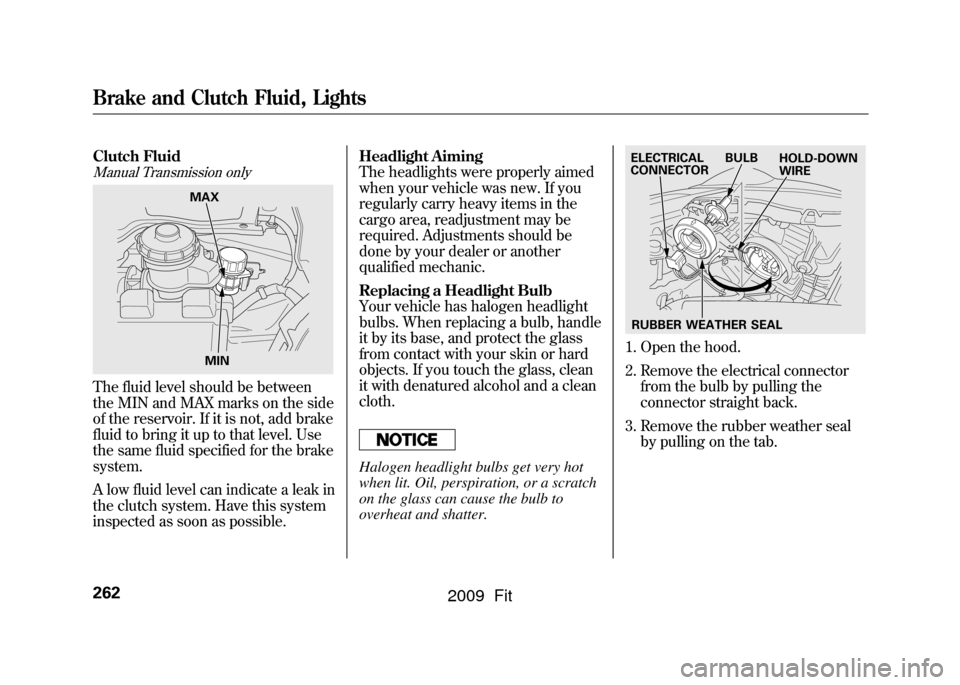
Clutch FluidManual Transmission onlyThe fluid level should be between
the MIN and MAX marks on the side
of the reservoir. If it is not, add brake
fluid to bring it up to that level. Use
the same fluid specified for the brake
system.
A low fluid level can indicate a leak in
the clutch system. Have this system
inspected as soon as possible.Headlight Aiming
The headlights were properly aimed
when your vehicle was new. If you
regularly carry heavy items in the
cargo area, readjustment may be
required. Adjustments should be
done by your dealer or another
qualified mechanic.
Replacing a Headlight Bulb
Your vehicle has halogen headlight
bulbs. When replacing a bulb, handle
it by its base, and protect the glass
from contact with your skin or hard
objects. If you touch the glass, clean
it with denatured alcohol and a clean
cloth.
Halogen headlight bulbs get very hot
when lit. Oil, perspiration, or a scratch
on the glass can cause the bulb to
overheat and shatter.
1. Open the hood.
2. Remove the electrical connector
from the bulb by pulling the
connector straight back.
3. Remove the rubber weather seal by pulling on the tab.
MAX
MIN
BULB
ELECTRICAL
CONNECTOR
RUBBER WEATHER SEAL HOLD-DOWN
WIRE
Brake and Clutch Fluid, Lights262
2009 Fit
Page 266 of 352
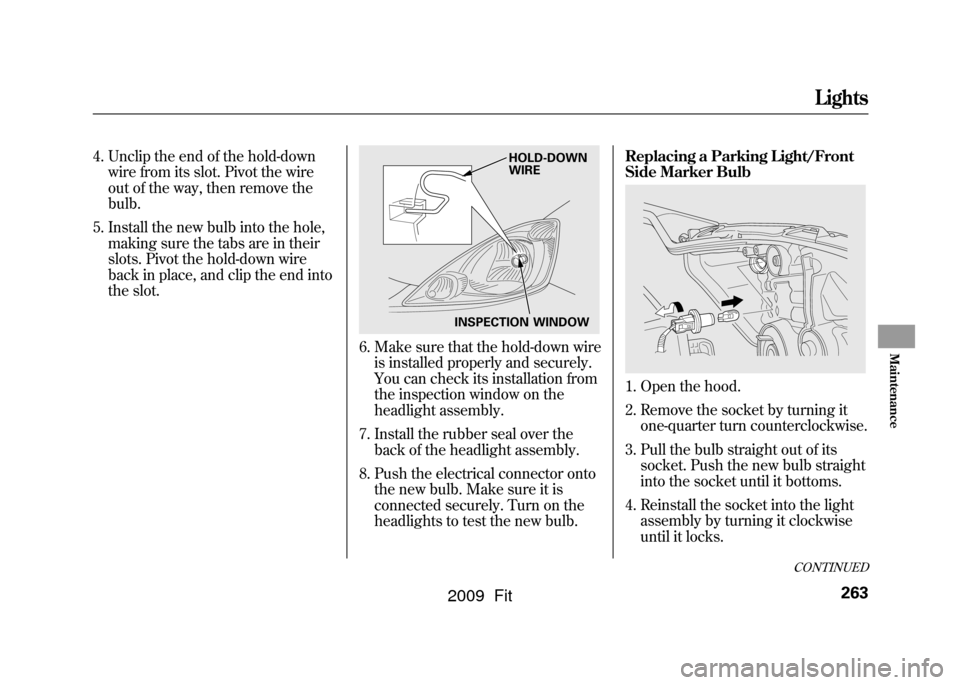
4. Unclip the end of the hold-downwire from its slot. Pivot the wire
out of the way, then remove the
bulb.
5. Install the new bulb into the hole, making sure the tabs are in their
slots. Pivot the hold-down wire
back in place, and clip the end into
the slot.
6. Make sure that the hold-down wireis installed properly and securely.
You can check its installation from
the inspection window on the
headlight assembly.
7. Install the rubber seal over the back of the headlight assembly.
8. Push the electrical connector onto the new bulb. Make sure it is
connected securely. Turn on the
headlights to test the new bulb. Replacing a Parking Light/Front
Side Marker Bulb
1. Open the hood.
2. Remove the socket by turning it
one-quarter turn counterclockwise.
3. Pull the bulb straight out of its socket. Push the new bulb straight
into the socket until it bottoms.
4. Reinstall the socket into the light assembly by turning it clockwise
until it locks.
INSPECTION WINDOW HOLD-DOWN
WIRE
CONTINUED
Lights
263
Maintenance
2009 Fit
Page 300 of 352
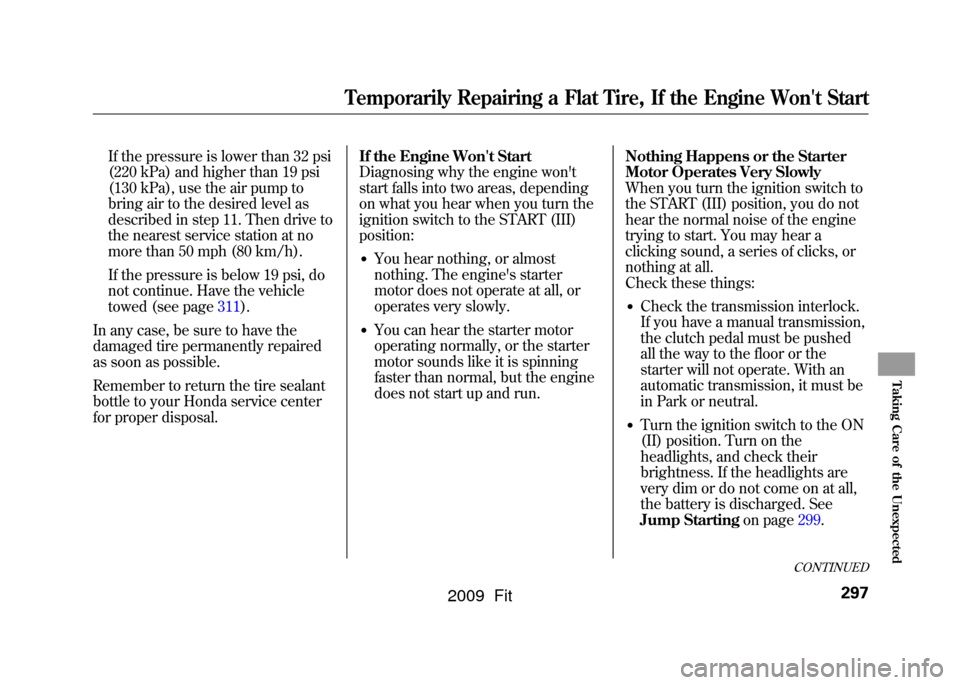
If the pressure is lower than 32 psi
(220 kPa) and higher than 19 psi
(130 kPa), use the air pump to
bring air to the desired level as
described in step 11. Then drive to
the nearest service station at no
more than 50 mph (80 km/h).
If the pressure is below 19 psi, do
not continue. Have the vehicle
towed (see page311).
In any case, be sure to have the
damaged tire permanently repaired
as soon as possible.
Remember to return the tire sealant
bottle to your Honda service center
for proper disposal. If the Engine Won't Start
Diagnosing why the engine won't
start falls into two areas, depending
on what you hear when you turn the
ignition switch to the START (III)
position:
●You hear nothing, or almost
nothing. The engine's starter
motor does not operate at all, or
operates very slowly.●You can hear the starter motor
operating normally, or the starter
motor sounds like it is spinning
faster than normal, but the engine
does not start up and run.
Nothing Happens or the Starter
Motor Operates Very Slowly
When you turn the ignition switch to
the START (III) position, you do not
hear the normal noise of the engine
trying to start. You may hear a
clicking sound, a series of clicks, or
nothing at all.
Check these things:
●Check the transmission interlock.
If you have a manual transmission,
the clutch pedal must be pushed
all the way to the floor or the
starter will not operate. With an
automatic transmission, it must be
in Park or neutral.●Turn the ignition switch to the ON
(II) position. Turn on the
headlights, and check their
brightness. If the headlights are
very dim or do not come on at all,
the battery is discharged. See
Jump Starting
on page299.
CONTINUED
Temporarily Repairing a Flat Tire, If the Engine Won't Start
297
Taking Care of the Unexpected
2009 Fit
Page 301 of 352
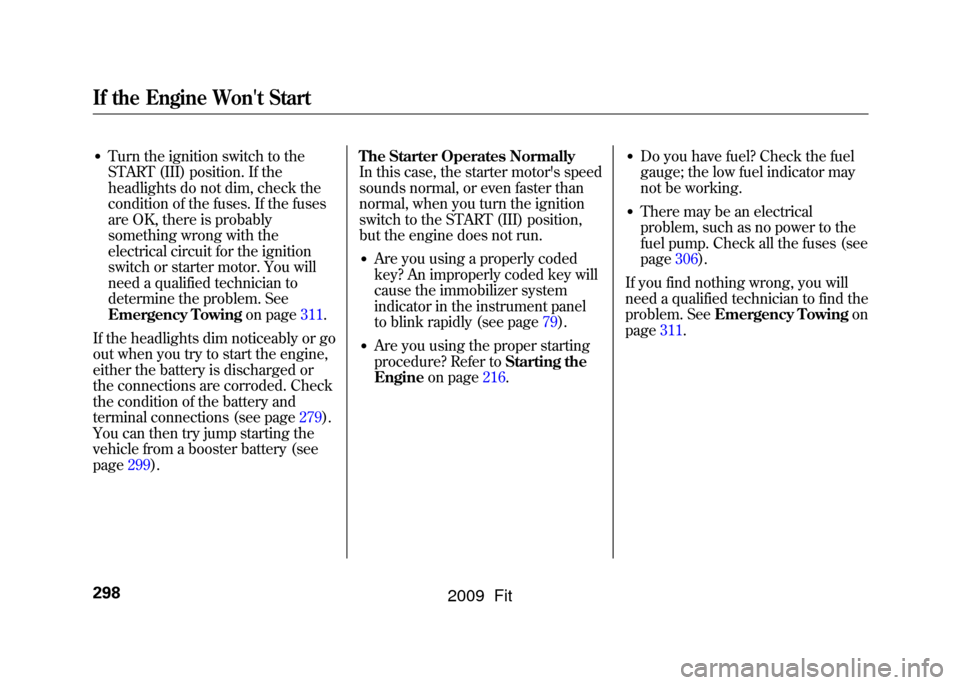
●Turn the ignition switch to the
START (III) position. If the
headlights do not dim, check the
condition of the fuses. If the fuses
are OK, there is probably
something wrong with the
electrical circuit for the ignition
switch or starter motor. You will
need a qualified technician to
determine the problem. See
Emergency Towingon page311.
If the headlights dim noticeably or go
out when you try to start the engine,
either the battery is discharged or
the connections are corroded. Check
the condition of the battery and
terminal connections (see page 279).
You can then try jump starting the
vehicle from a booster battery (see
page 299). The Starter Operates Normally
In this case, the starter motor's speed
sounds normal, or even faster than
normal, when you turn the ignition
switch to the START (III) position,
but the engine does not run.
●Are you using a properly coded
key? An improperly coded key will
cause the immobilizer system
indicator in the instrument panel
to blink rapidly (see page79).●Are you using the proper starting
procedure? Refer to
Starting the
Engine on page216.
●Do you have fuel? Check the fuel
gauge; the low fuel indicator may
not be working.●There may be an electrical
problem, such as no power to the
fuel pump. Check all the fuses (see
page306).
If you find nothing wrong, you will
need a qualified technician to find the
problem. See Emergency Towing on
page311.
If the Engine Won't Start298
2009 Fit
Page 310 of 352
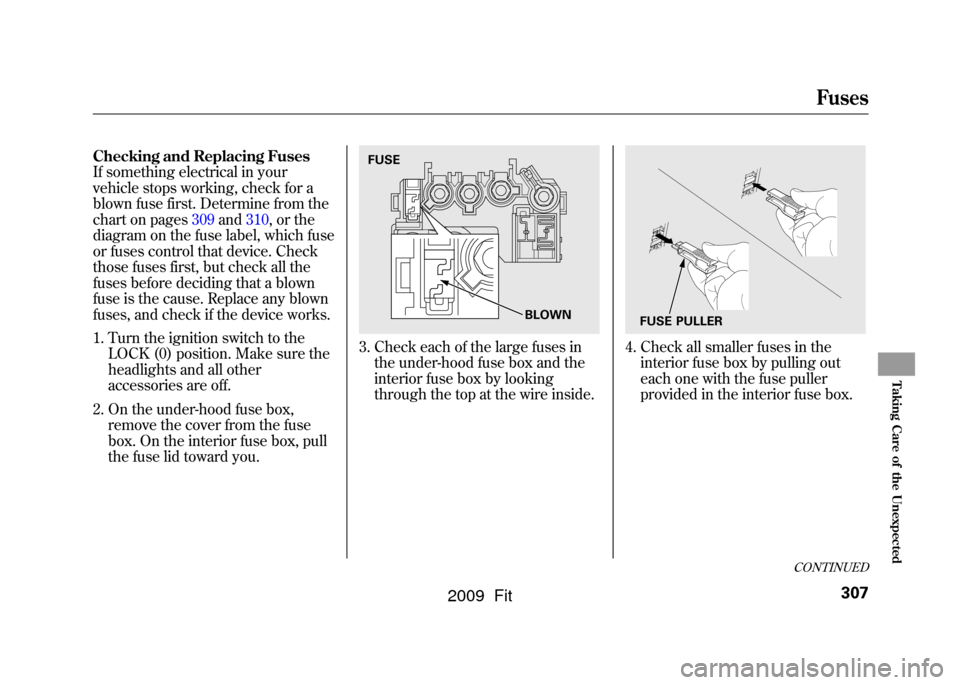
Checking and Replacing Fuses
If something electrical in your
vehicle stops working, check for a
blown fuse first. Determine from the
chart on pages309and310,or the
diagram on the fuse label, which fuse
or fuses control that device. Check
those fuses first, but check all the
fuses before deciding that a blown
fuse is the cause. Replace any blown
fuses, and check if the device works.
1. Turn the ignition switch to theLOCK (0) position. Make sure the
headlights and all other
accessories are off.
2. On the under-hood fuse box, remove the cover from the fuse
box. On the interior fuse box, pull
the fuse lid toward you.
3. Check each of the large fuses inthe under-hood fuse box and the
interior fuse box by looking
through the top at the wire inside.
4. Check all smaller fuses in theinterior fuse box by pulling out
each one with the fuse puller
provided in the interior fuse box.
FUSE
BLOWN
FUSE PULLER
CONTINUED
Fuses
307
Taking Care of the Unexpected
2009 Fit
Page 322 of 352

CapacitiesFuel tank Approx.
10.6 US gal (40 L)
Engine oil Change
ꭧ1Including
filter 3.8 US qt (3.6 L)
Without filter 3.6 US qt (3.4 L)
Total 4.4 US qt (4.2 L)
Engine
coolant Automatic
transmission
Changeꭧ2
1.19 US gal (4.5 L)
Total 1.32 US gal (5.0 L)
Manual transmission
Change
ꭧ2
1.16 US gal (4.4 L)
Total 1.29 US gal (4.9 L)
Automatic
transmission
fluid Change
2.6 US qt (2.5 L)
Total 6.18 US qt (5.85 L)
Manual
transmisson fluid Change
1.6 US qt (1.5 L)
Total 1.7 US qt (1.6 L)
Windshield
washer reservoir U.S. Vehicles 2.6 US qt (2.5 L)
Canada Vehicles 4.8 US qt (4.5 L)
ꭧ 1: Excluding the oil remaining in the engine
ꭧ 2: Including the coolant in the reserve tank and that remaining in the engine
Reserve tank capacity:
0.116 US gal (0.44 L)
Air Conditioning
Refrigerant type HFC-134a (R-134a)
Charge quantity 13.1-14.8 oz
(370 -420 g)
Lubricant type SP-10
Lights Headlights High/Low 12 V -60/55W (HB2)
Front turn signal lights 12 V-21W (Amber)
Parking lights/side marker
lights 12 V
-3.8W (Amber)
Fog lights
ꭧ
12 V -55W (H11)
Rear turn signal lights 12 V-21W (Amber)
Stop/Taillights 12 V-21/5W
Back-up lights 12 V-16W
License plate lights 12 V-5W
Ceiling light 12 V-8W
Cargo area light 12 V-5W
Map light
ꭧ
12 V -8W
High-mount brake light LED
ꭧ : For some types
Specifications
319
Technical Information
2009 Fit
Page 341 of 352

Bulb ReplacementBack-up Lights
........................
266
Brake Lights
...........................
266
Fog Lights
...............................
265
Front Parking Lights
...............
263
Front Side Marker Lights
........
263
Headlights
..............................
262
Rear Bulbs
..............................
266
Specifications
..........................
319
Taillights
.................................
266
Turn Signal Lights
..........
263, 266
Bulbs, Halogen
..........................
262
C
Cancel Button
............................
196
Capacities Chart
.........................
318
Carbon Monoxide Hazard
............
53
Cargo
.........................................
208
Cargo Hook
................................
212
Cargo, How to Carry
..................
208
Carrying Cargo
..........................
208
CAUTION, Explanation of
............
iii
CD Care
.....................................
186
CD Error Messages
............
128, 157 CD Player
...........................
122,
149
Certification Label
......................
316
Chains, Tires
..............................
278
Changing a Flat Tire
..................
285
Changing Oil How to
....................................
254
When to
..................................
245
Charging System Indicator
...........................
60, 303
Check Fuel Cap Indicator
.............
70
Checklist, Before Driving
...........
215
Childproof Door Locks
.................
82
Child Safety
..................................
34
Booster Seats
...........................
50
Child Seats
..........................
39, 41
Important Safety Reminders.....
38
Infants
......................................
39
Large Children
.........................
49
LATCH
.....................................
43
Risks with Airbags
...................
35
Small Children
.........................
40
Tethers
....................................
47
Warning Labels
........................
36
Where Should a Child Sit?
........
35
Child Seats
.............................
34, 41
LATCH Anchorage Points
........
43 Tether Anchorage Points
.........
47
Cleaning the Seat Belts
..............
267
Clock
..........................................
192
Clutch Fluid
...............................
261
Code, Audio System
...................
191
CO in the Exhaust
................
53, 326
Cold Weather, Starting in
...........
216
Compact Spare Tire
....................
284
Consumer Information (U.S. only)
.......................................
332
Controls, Instruments and
............
57
Coolant Adding
....................................
256
Checking
................................
202
Proper Solution
.......................
256
Temperature Indicator
.............
63
Crankcase Emissions Control System
...................................
326
Cruise Control Indicator
...............
65
Cruise Control Operation
...........
194
Cup Holders
...............................
106
Current Fuel Mileage
...................
70
Customer Service Office
............
332
IndexII
2009 Fit